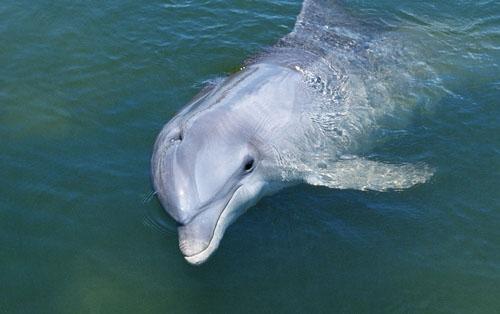(单词翻译:单击)
Chinese conservationists believe they may have caught a rare glimpse of a freshwater dolphin that was declared functionally extinct a decade ago having graced the Yangtze river for 20 million years.
十年前,在扬子江中存在了2千万年的白鳍豚宣告功能性灭绝。不过近日,中国的某些动物保护人士却认为自己看到了这种已灭绝的海豚。
Scientists and environmentalists had appeared to abandon hope that China's baiji, or white dolphin, could survive as a species after they failed to find a single animal during a fruitless six-week hunt along the 6,300-km (3,915-mile) waterway in 2006.
2006年,科学家和环境学家曾在长度达6300公里的扬子江流域展开了为期六周的搜寻行动,却一无所获。从此科学界对白鳍豚仍存于世不抱希望。
But a team of amateur conservationists now claims it spotted the so-called "goddess of the Yangtze" last week on a stretch of Asia's longest river near the city of Wuhu in Anhui province.
然而,一支由民间动物保护人士组成的科考队声称,他们于上周在安徽省芜湖市旁扬子江的支流中发现了这种被称为“长江女神”的动物的踪迹。
"No other creature could jump out of the Yangtze like that," Song Qi, the leader of that expedition told Sixth Tone, a government-backed news website. "All the eyewitnesses – which include fishermen – felt certain that it was a baiji."
科考队队长宋奇在接受政府支持的新闻网站第六声采访时表示:“其他动物不会像那样跃出水面。包括渔民在内的目击者都认为那就是一只白鳍豚。”

At just after 9.20am on 4 October he recalled spotting a "white dot" emerge from the river. Soon after a "white light" appeared to puncture the surface of the water for a second time. Seconds later Song spotted what he believes was the baiji for the third and final time, swimming towards the river's eastern bank.
据宋奇回忆,他在十月四日上午九点二十分过后发现江面上出现了一个"白点",几秒钟后,一道"白光"跃出水面。又过了几秒钟后,宋奇最后一次看到了他确信为白鳍豚的生物,当时它正在向河的东岸游去。
The amateur conservationist, whose day job is as a publisher in Beijing, admitted he was not a baiji specialist and could not be totally sure the animal he had seen was the aquatic mammal. His group captured no images that might conclusively identify it.
平时宋奇在北京从事出版生意。他承认自己并非专家,无法确认自己看到的是否是真正的白鳍豚。科考队队员也未能及时拍到"白鳍豚"的独家照片。
But Song said local fisherman who had also seen the creature were "100% certain" it was the baiji.
但是宋奇表示,凡是亲眼目睹该生物的当地渔民都百分之百确信自己看到的就是白鳍豚。
With the apparent confirmation of its demise, the narrow-beaked river dolphin has become a symbol of the devastating environmental price China has paid for decades of unbridled development.
白鳍豚的灭绝曾得到了科学界的证实。数十年来,中国已经因过快发展付出了巨大的环境代价,这种已灭绝的尖嘴海豚已经成为这种代价的标志。
In the 1950s, the Yangtze is thought to have been home to thousands of such animals.
20世纪50年代,人们认为扬子江中还存在着上千种动物。
But by the end of the 1980s that number had fallen to perhaps 200 thanks to a lethal cocktail of dam-building, over-fishing, pollution and boat traffic.
但此后的种种现象,如兴建大坝、过度捕猎、江水污染和沉船事故严重破坏了扬子江的环境。拜此所赐,到20世纪80年代为止,扬子江中的动物锐减至200种左右。
By the turn of the century just 13 remained, according to one survey.
一项调查显示,江中动物在世纪之交时仅剩下了13种。
Song said he hoped his team's unconfirmed baiji sighting would prompt renewed efforts to save the species.
宋奇表示,他希望此次科考队的匆匆一瞥能促使人们重新投入拯救白鳍豚的行动。
He vowed to launch another expedition along the Yangtze early next year. "I want society to realise that the baiji is not extinct," he said.
他承诺明年年初将再次前往扬子江进行考察:"我希望全社会意识到白鳍豚还没有灭绝"。


